A Review of Mobile App Usage in Diabetes Management and Patient Care
VerifiedAdded on 2022/08/12
|15
|2405
|15
Report
AI Summary
This report examines the use of mobile applications in diabetes management and care. It begins with a description of the search criteria used to find relevant articles, including inclusion and exclusion criteria, keywords, and databases. The report then presents a matrix of five articles, summarizing their purpose, design, sampling methods, instruments, results, and strengths and weaknesses. The articles explore various aspects of mobile app use, such as self-management of type 2 diabetes, the development and testing of mobile applications, and the use of mobile health technology in vulnerable populations. The matrix provides a comparative analysis of the studies, highlighting key findings and limitations. The report concludes by emphasizing the potential of mobile apps to improve diabetes care and patient outcomes, as well as the need for further research and development in this area. The report is a comprehensive overview of the current literature on the topic.
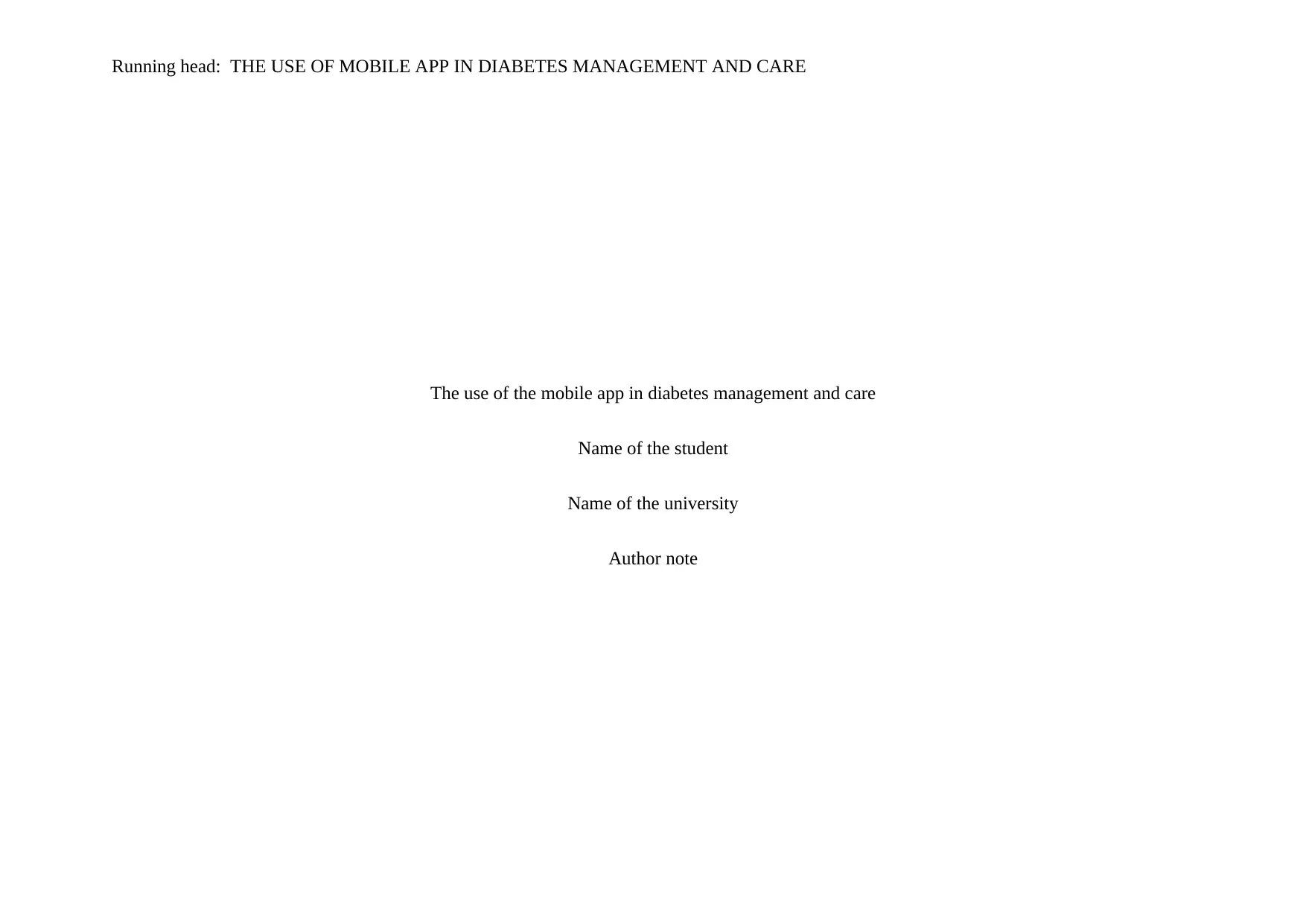
Running head: THE USE OF MOBILE APP IN DIABETES MANAGEMENT AND CARE
The use of the mobile app in diabetes management and care
Name of the student
Name of the university
Author note
The use of the mobile app in diabetes management and care
Name of the student
Name of the university
Author note
Paraphrase This Document
Need a fresh take? Get an instant paraphrase of this document with our AI Paraphraser
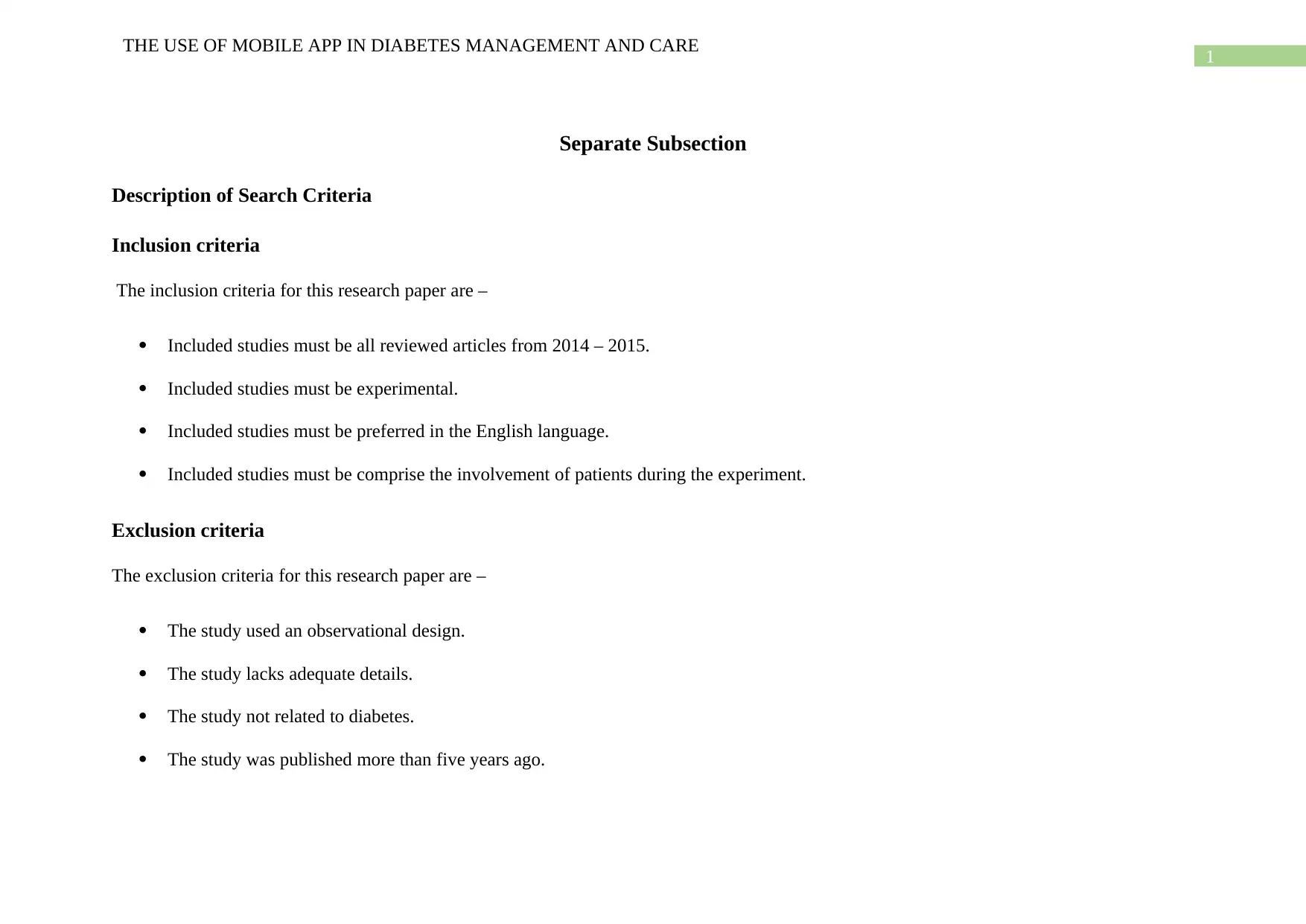
1
THE USE OF MOBILE APP IN DIABETES MANAGEMENT AND CARE
Separate Subsection
Description of Search Criteria
Inclusion criteria
The inclusion criteria for this research paper are –
Included studies must be all reviewed articles from 2014 – 2015.
Included studies must be experimental.
Included studies must be preferred in the English language.
Included studies must be comprise the involvement of patients during the experiment.
Exclusion criteria
The exclusion criteria for this research paper are –
The study used an observational design.
The study lacks adequate details.
The study not related to diabetes.
The study was published more than five years ago.
THE USE OF MOBILE APP IN DIABETES MANAGEMENT AND CARE
Separate Subsection
Description of Search Criteria
Inclusion criteria
The inclusion criteria for this research paper are –
Included studies must be all reviewed articles from 2014 – 2015.
Included studies must be experimental.
Included studies must be preferred in the English language.
Included studies must be comprise the involvement of patients during the experiment.
Exclusion criteria
The exclusion criteria for this research paper are –
The study used an observational design.
The study lacks adequate details.
The study not related to diabetes.
The study was published more than five years ago.
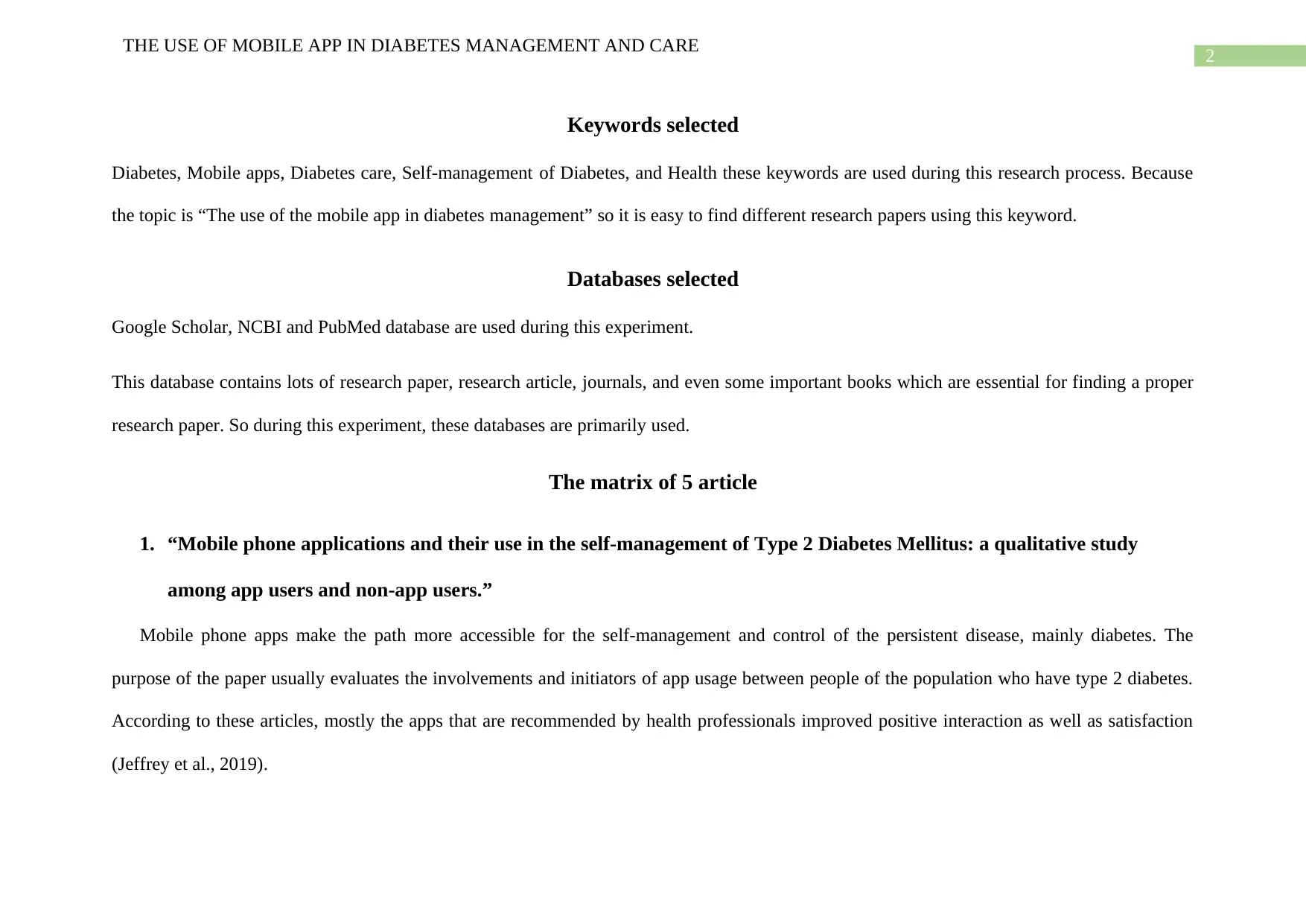
2
THE USE OF MOBILE APP IN DIABETES MANAGEMENT AND CARE
Keywords selected
Diabetes, Mobile apps, Diabetes care, Self-management of Diabetes, and Health these keywords are used during this research process. Because
the topic is “The use of the mobile app in diabetes management” so it is easy to find different research papers using this keyword.
Databases selected
Google Scholar, NCBI and PubMed database are used during this experiment.
This database contains lots of research paper, research article, journals, and even some important books which are essential for finding a proper
research paper. So during this experiment, these databases are primarily used.
The matrix of 5 article
1. “Mobile phone applications and their use in the self-management of Type 2 Diabetes Mellitus: a qualitative study
among app users and non-app users.”
Mobile phone apps make the path more accessible for the self-management and control of the persistent disease, mainly diabetes. The
purpose of the paper usually evaluates the involvements and initiators of app usage between people of the population who have type 2 diabetes.
According to these articles, mostly the apps that are recommended by health professionals improved positive interaction as well as satisfaction
(Jeffrey et al., 2019).
THE USE OF MOBILE APP IN DIABETES MANAGEMENT AND CARE
Keywords selected
Diabetes, Mobile apps, Diabetes care, Self-management of Diabetes, and Health these keywords are used during this research process. Because
the topic is “The use of the mobile app in diabetes management” so it is easy to find different research papers using this keyword.
Databases selected
Google Scholar, NCBI and PubMed database are used during this experiment.
This database contains lots of research paper, research article, journals, and even some important books which are essential for finding a proper
research paper. So during this experiment, these databases are primarily used.
The matrix of 5 article
1. “Mobile phone applications and their use in the self-management of Type 2 Diabetes Mellitus: a qualitative study
among app users and non-app users.”
Mobile phone apps make the path more accessible for the self-management and control of the persistent disease, mainly diabetes. The
purpose of the paper usually evaluates the involvements and initiators of app usage between people of the population who have type 2 diabetes.
According to these articles, mostly the apps that are recommended by health professionals improved positive interaction as well as satisfaction
(Jeffrey et al., 2019).
⊘ This is a preview!⊘
Do you want full access?
Subscribe today to unlock all pages.

Trusted by 1+ million students worldwide
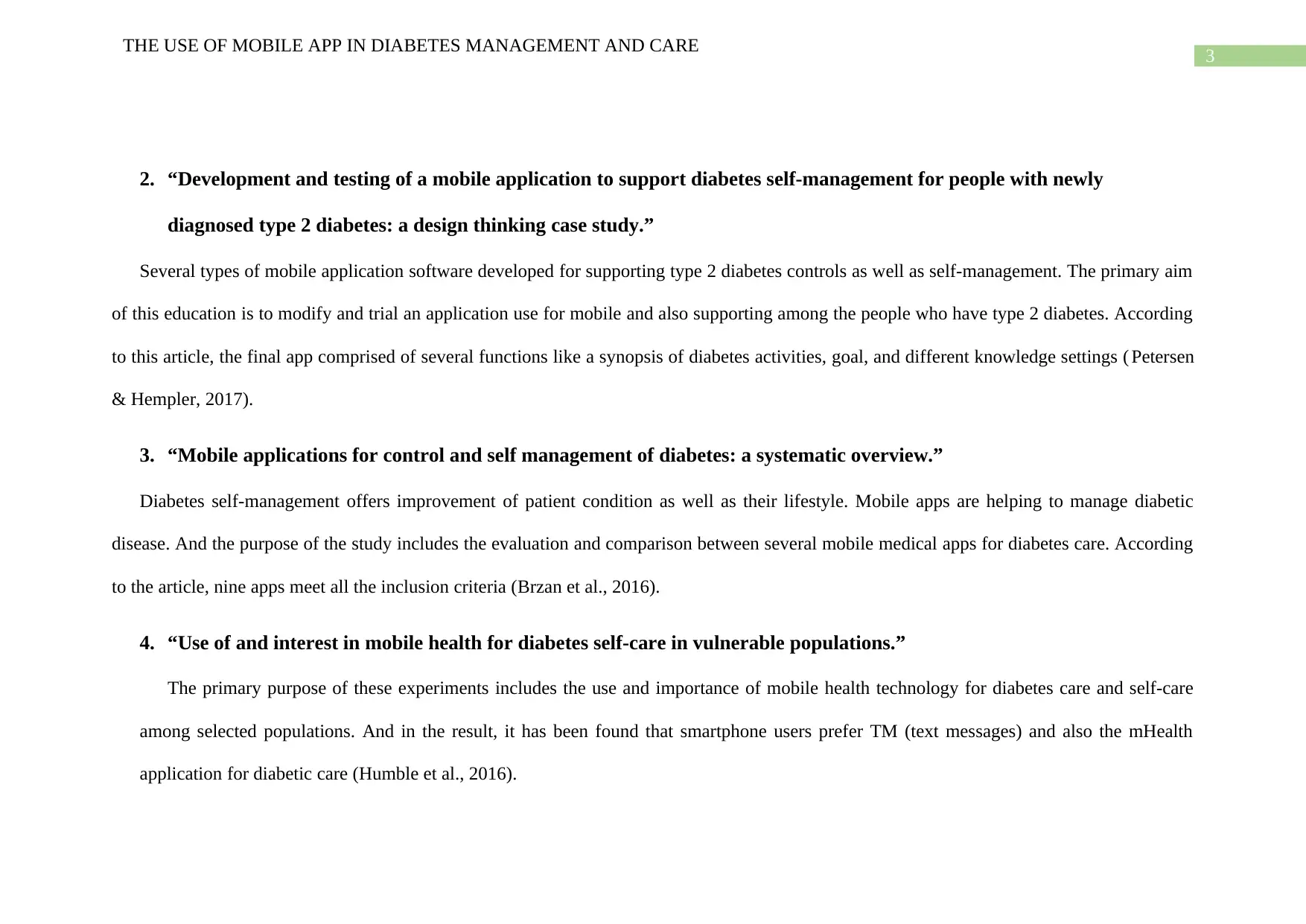
3
THE USE OF MOBILE APP IN DIABETES MANAGEMENT AND CARE
2. “Development and testing of a mobile application to support diabetes self-management for people with newly
diagnosed type 2 diabetes: a design thinking case study.”
Several types of mobile application software developed for supporting type 2 diabetes controls as well as self-management. The primary aim
of this education is to modify and trial an application use for mobile and also supporting among the people who have type 2 diabetes. According
to this article, the final app comprised of several functions like a synopsis of diabetes activities, goal, and different knowledge settings ( Petersen
& Hempler, 2017).
3. “Mobile applications for control and self management of diabetes: a systematic overview.”
Diabetes self-management offers improvement of patient condition as well as their lifestyle. Mobile apps are helping to manage diabetic
disease. And the purpose of the study includes the evaluation and comparison between several mobile medical apps for diabetes care. According
to the article, nine apps meet all the inclusion criteria (Brzan et al., 2016).
4. “Use of and interest in mobile health for diabetes self-care in vulnerable populations.”
The primary purpose of these experiments includes the use and importance of mobile health technology for diabetes care and self-care
among selected populations. And in the result, it has been found that smartphone users prefer TM (text messages) and also the mHealth
application for diabetic care (Humble et al., 2016).
THE USE OF MOBILE APP IN DIABETES MANAGEMENT AND CARE
2. “Development and testing of a mobile application to support diabetes self-management for people with newly
diagnosed type 2 diabetes: a design thinking case study.”
Several types of mobile application software developed for supporting type 2 diabetes controls as well as self-management. The primary aim
of this education is to modify and trial an application use for mobile and also supporting among the people who have type 2 diabetes. According
to this article, the final app comprised of several functions like a synopsis of diabetes activities, goal, and different knowledge settings ( Petersen
& Hempler, 2017).
3. “Mobile applications for control and self management of diabetes: a systematic overview.”
Diabetes self-management offers improvement of patient condition as well as their lifestyle. Mobile apps are helping to manage diabetic
disease. And the purpose of the study includes the evaluation and comparison between several mobile medical apps for diabetes care. According
to the article, nine apps meet all the inclusion criteria (Brzan et al., 2016).
4. “Use of and interest in mobile health for diabetes self-care in vulnerable populations.”
The primary purpose of these experiments includes the use and importance of mobile health technology for diabetes care and self-care
among selected populations. And in the result, it has been found that smartphone users prefer TM (text messages) and also the mHealth
application for diabetic care (Humble et al., 2016).
Paraphrase This Document
Need a fresh take? Get an instant paraphrase of this document with our AI Paraphraser
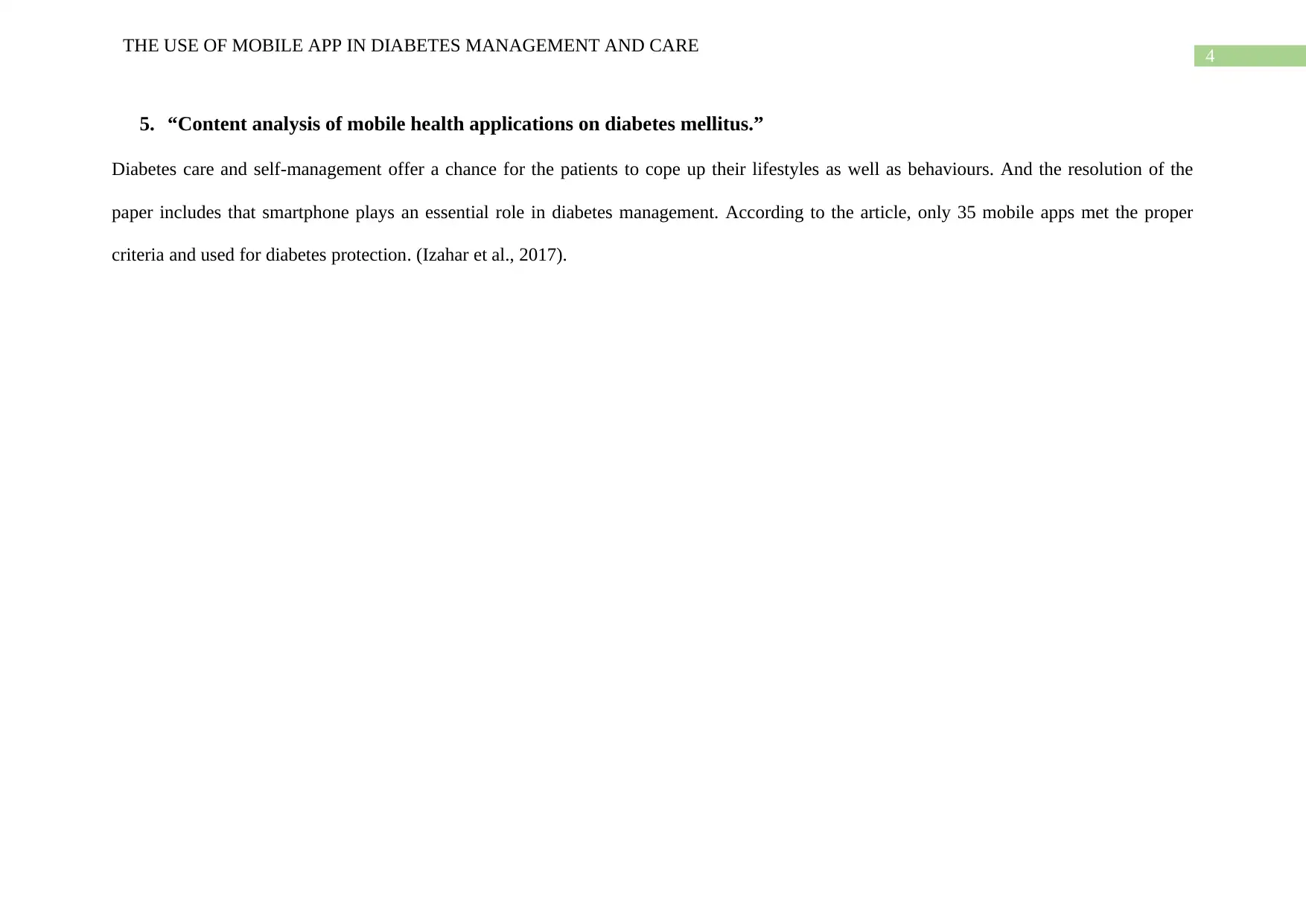
4
THE USE OF MOBILE APP IN DIABETES MANAGEMENT AND CARE
5. “Content analysis of mobile health applications on diabetes mellitus.”
Diabetes care and self-management offer a chance for the patients to cope up their lifestyles as well as behaviours. And the resolution of the
paper includes that smartphone plays an essential role in diabetes management. According to the article, only 35 mobile apps met the proper
criteria and used for diabetes protection. (Izahar et al., 2017).
THE USE OF MOBILE APP IN DIABETES MANAGEMENT AND CARE
5. “Content analysis of mobile health applications on diabetes mellitus.”
Diabetes care and self-management offer a chance for the patients to cope up their lifestyles as well as behaviours. And the resolution of the
paper includes that smartphone plays an essential role in diabetes management. According to the article, only 35 mobile apps met the proper
criteria and used for diabetes protection. (Izahar et al., 2017).
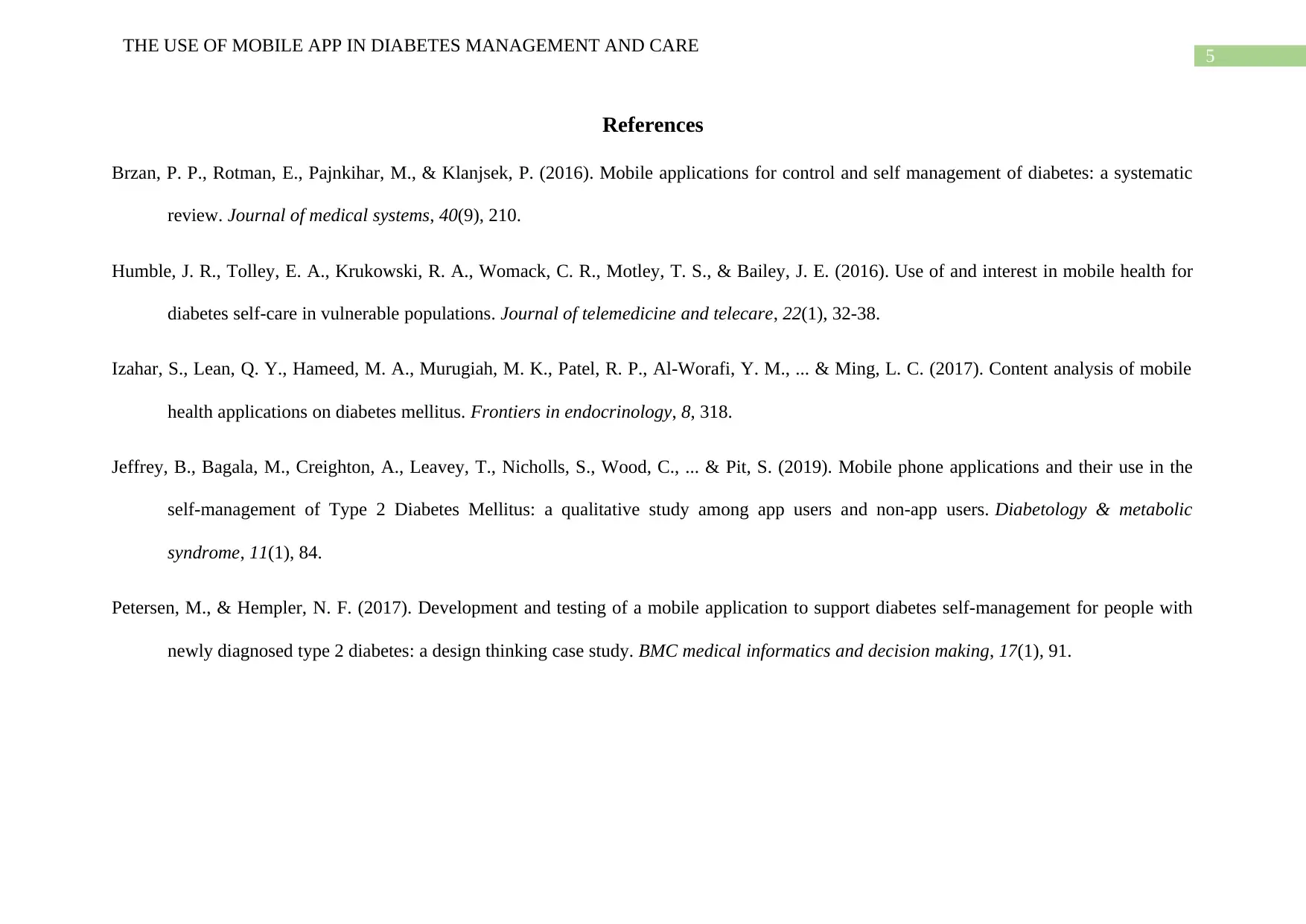
5
THE USE OF MOBILE APP IN DIABETES MANAGEMENT AND CARE
References
Brzan, P. P., Rotman, E., Pajnkihar, M., & Klanjsek, P. (2016). Mobile applications for control and self management of diabetes: a systematic
review. Journal of medical systems, 40(9), 210.
Humble, J. R., Tolley, E. A., Krukowski, R. A., Womack, C. R., Motley, T. S., & Bailey, J. E. (2016). Use of and interest in mobile health for
diabetes self-care in vulnerable populations. Journal of telemedicine and telecare, 22(1), 32-38.
Izahar, S., Lean, Q. Y., Hameed, M. A., Murugiah, M. K., Patel, R. P., Al-Worafi, Y. M., ... & Ming, L. C. (2017). Content analysis of mobile
health applications on diabetes mellitus. Frontiers in endocrinology, 8, 318.
Jeffrey, B., Bagala, M., Creighton, A., Leavey, T., Nicholls, S., Wood, C., ... & Pit, S. (2019). Mobile phone applications and their use in the
self-management of Type 2 Diabetes Mellitus: a qualitative study among app users and non-app users. Diabetology & metabolic
syndrome, 11(1), 84.
Petersen, M., & Hempler, N. F. (2017). Development and testing of a mobile application to support diabetes self-management for people with
newly diagnosed type 2 diabetes: a design thinking case study. BMC medical informatics and decision making, 17(1), 91.
THE USE OF MOBILE APP IN DIABETES MANAGEMENT AND CARE
References
Brzan, P. P., Rotman, E., Pajnkihar, M., & Klanjsek, P. (2016). Mobile applications for control and self management of diabetes: a systematic
review. Journal of medical systems, 40(9), 210.
Humble, J. R., Tolley, E. A., Krukowski, R. A., Womack, C. R., Motley, T. S., & Bailey, J. E. (2016). Use of and interest in mobile health for
diabetes self-care in vulnerable populations. Journal of telemedicine and telecare, 22(1), 32-38.
Izahar, S., Lean, Q. Y., Hameed, M. A., Murugiah, M. K., Patel, R. P., Al-Worafi, Y. M., ... & Ming, L. C. (2017). Content analysis of mobile
health applications on diabetes mellitus. Frontiers in endocrinology, 8, 318.
Jeffrey, B., Bagala, M., Creighton, A., Leavey, T., Nicholls, S., Wood, C., ... & Pit, S. (2019). Mobile phone applications and their use in the
self-management of Type 2 Diabetes Mellitus: a qualitative study among app users and non-app users. Diabetology & metabolic
syndrome, 11(1), 84.
Petersen, M., & Hempler, N. F. (2017). Development and testing of a mobile application to support diabetes self-management for people with
newly diagnosed type 2 diabetes: a design thinking case study. BMC medical informatics and decision making, 17(1), 91.
⊘ This is a preview!⊘
Do you want full access?
Subscribe today to unlock all pages.

Trusted by 1+ million students worldwide
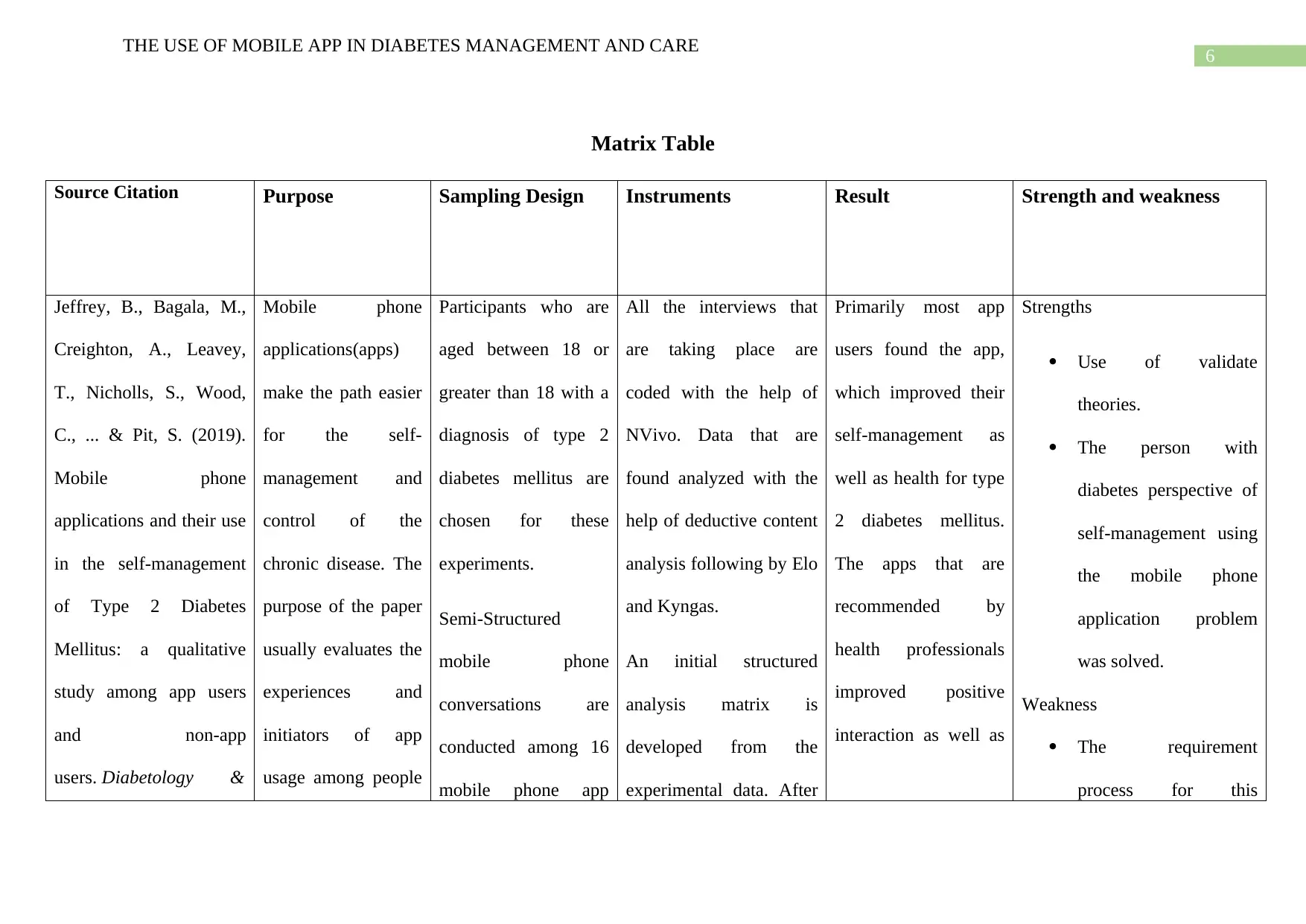
6
THE USE OF MOBILE APP IN DIABETES MANAGEMENT AND CARE
Matrix Table
Source Citation Purpose Sampling Design Instruments Result Strength and weakness
Jeffrey, B., Bagala, M.,
Creighton, A., Leavey,
T., Nicholls, S., Wood,
C., ... & Pit, S. (2019).
Mobile phone
applications and their use
in the self-management
of Type 2 Diabetes
Mellitus: a qualitative
study among app users
and non-app
users. Diabetology &
Mobile phone
applications(apps)
make the path easier
for the self-
management and
control of the
chronic disease. The
purpose of the paper
usually evaluates the
experiences and
initiators of app
usage among people
Participants who are
aged between 18 or
greater than 18 with a
diagnosis of type 2
diabetes mellitus are
chosen for these
experiments.
Semi-Structured
mobile phone
conversations are
conducted among 16
mobile phone app
All the interviews that
are taking place are
coded with the help of
NVivo. Data that are
found analyzed with the
help of deductive content
analysis following by Elo
and Kyngas.
An initial structured
analysis matrix is
developed from the
experimental data. After
Primarily most app
users found the app,
which improved their
self-management as
well as health for type
2 diabetes mellitus.
The apps that are
recommended by
health professionals
improved positive
interaction as well as
Strengths
Use of validate
theories.
The person with
diabetes perspective of
self-management using
the mobile phone
application problem
was solved.
Weakness
The requirement
process for this
THE USE OF MOBILE APP IN DIABETES MANAGEMENT AND CARE
Matrix Table
Source Citation Purpose Sampling Design Instruments Result Strength and weakness
Jeffrey, B., Bagala, M.,
Creighton, A., Leavey,
T., Nicholls, S., Wood,
C., ... & Pit, S. (2019).
Mobile phone
applications and their use
in the self-management
of Type 2 Diabetes
Mellitus: a qualitative
study among app users
and non-app
users. Diabetology &
Mobile phone
applications(apps)
make the path easier
for the self-
management and
control of the
chronic disease. The
purpose of the paper
usually evaluates the
experiences and
initiators of app
usage among people
Participants who are
aged between 18 or
greater than 18 with a
diagnosis of type 2
diabetes mellitus are
chosen for these
experiments.
Semi-Structured
mobile phone
conversations are
conducted among 16
mobile phone app
All the interviews that
are taking place are
coded with the help of
NVivo. Data that are
found analyzed with the
help of deductive content
analysis following by Elo
and Kyngas.
An initial structured
analysis matrix is
developed from the
experimental data. After
Primarily most app
users found the app,
which improved their
self-management as
well as health for type
2 diabetes mellitus.
The apps that are
recommended by
health professionals
improved positive
interaction as well as
Strengths
Use of validate
theories.
The person with
diabetes perspective of
self-management using
the mobile phone
application problem
was solved.
Weakness
The requirement
process for this
Paraphrase This Document
Need a fresh take? Get an instant paraphrase of this document with our AI Paraphraser
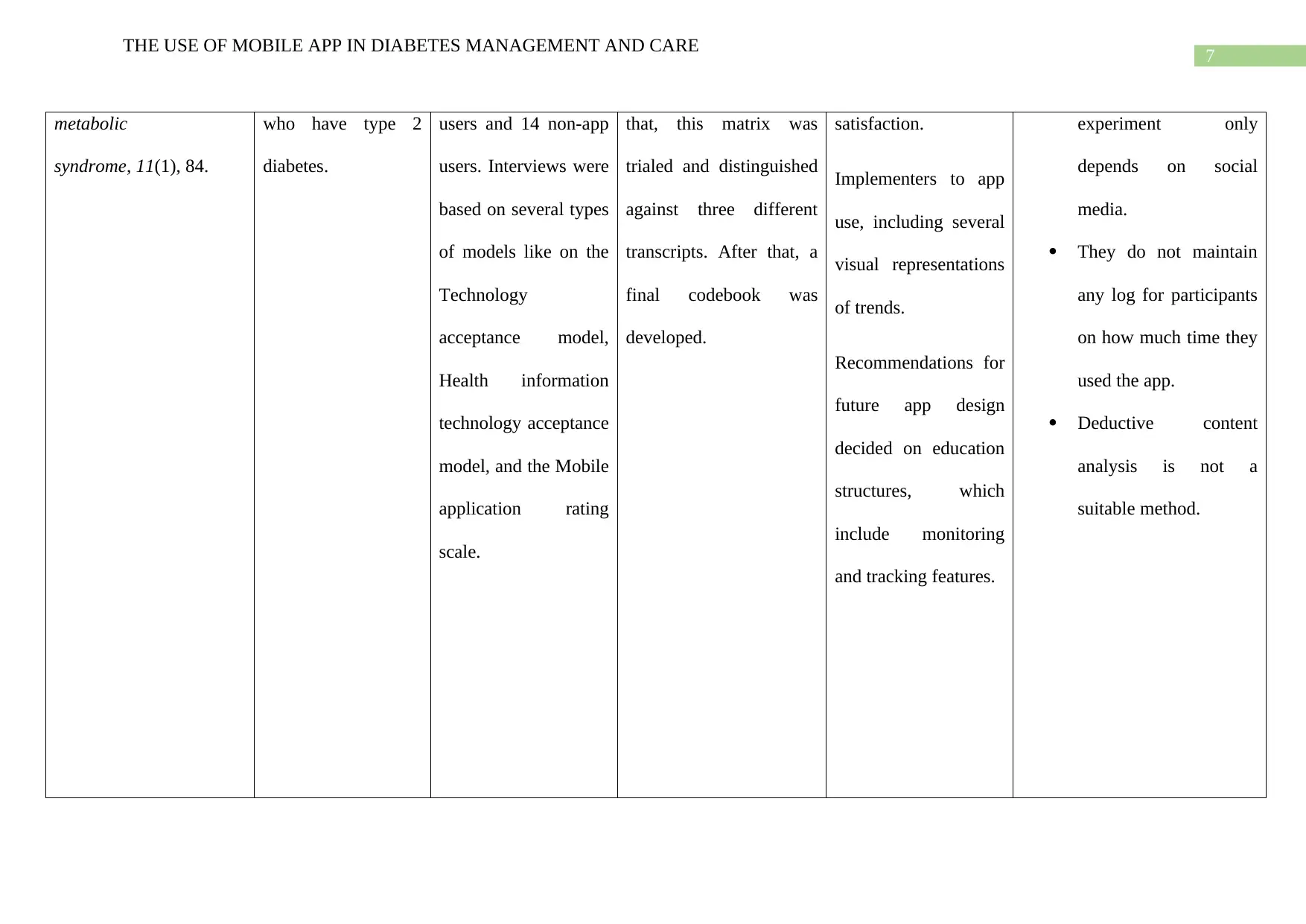
7
THE USE OF MOBILE APP IN DIABETES MANAGEMENT AND CARE
metabolic
syndrome, 11(1), 84.
who have type 2
diabetes.
users and 14 non-app
users. Interviews were
based on several types
of models like on the
Technology
acceptance model,
Health information
technology acceptance
model, and the Mobile
application rating
scale.
that, this matrix was
trialed and distinguished
against three different
transcripts. After that, a
final codebook was
developed.
satisfaction.
Implementers to app
use, including several
visual representations
of trends.
Recommendations for
future app design
decided on education
structures, which
include monitoring
and tracking features.
experiment only
depends on social
media.
They do not maintain
any log for participants
on how much time they
used the app.
Deductive content
analysis is not a
suitable method.
THE USE OF MOBILE APP IN DIABETES MANAGEMENT AND CARE
metabolic
syndrome, 11(1), 84.
who have type 2
diabetes.
users and 14 non-app
users. Interviews were
based on several types
of models like on the
Technology
acceptance model,
Health information
technology acceptance
model, and the Mobile
application rating
scale.
that, this matrix was
trialed and distinguished
against three different
transcripts. After that, a
final codebook was
developed.
satisfaction.
Implementers to app
use, including several
visual representations
of trends.
Recommendations for
future app design
decided on education
structures, which
include monitoring
and tracking features.
experiment only
depends on social
media.
They do not maintain
any log for participants
on how much time they
used the app.
Deductive content
analysis is not a
suitable method.
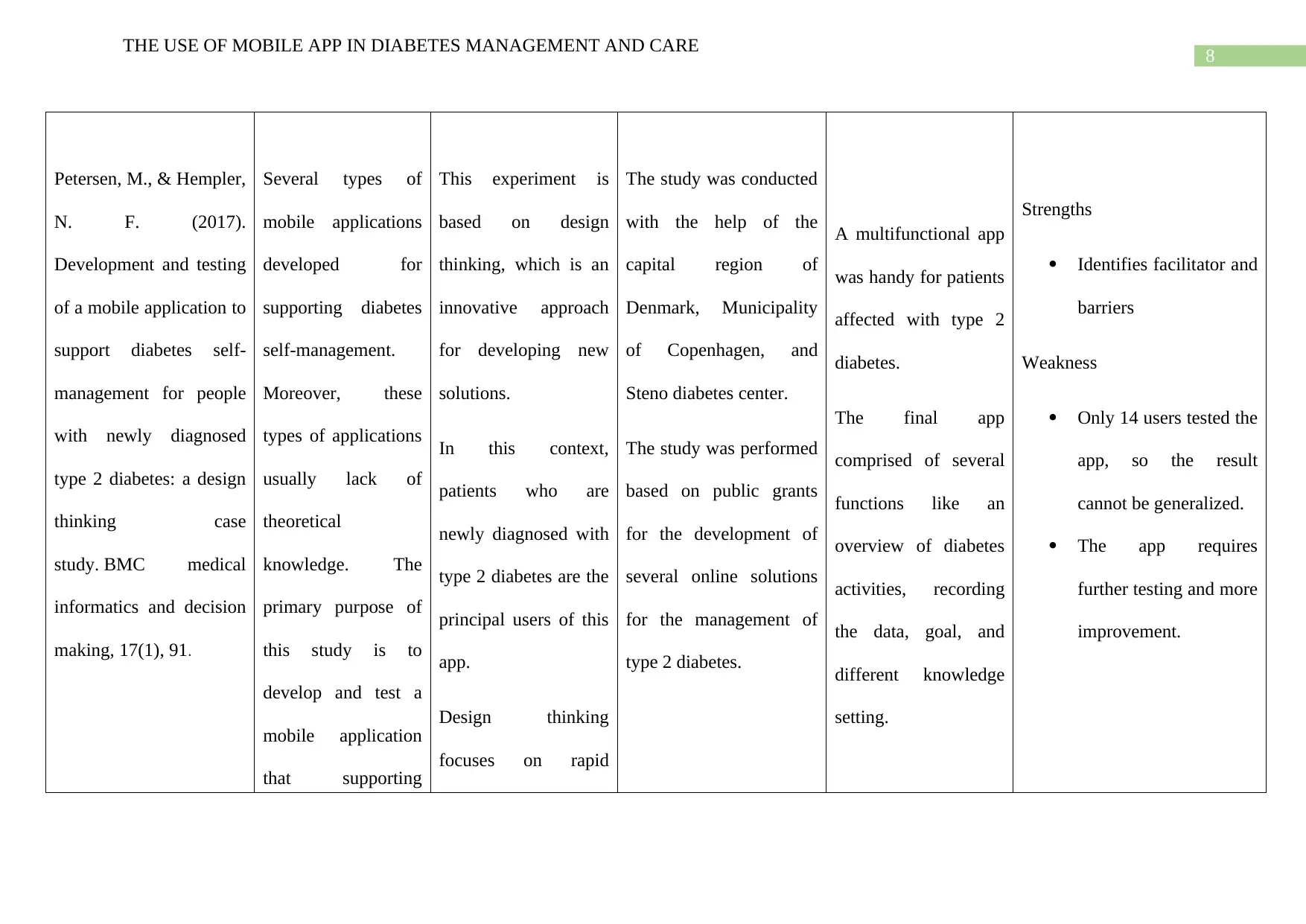
8
THE USE OF MOBILE APP IN DIABETES MANAGEMENT AND CARE
Petersen, M., & Hempler,
N. F. (2017).
Development and testing
of a mobile application to
support diabetes self-
management for people
with newly diagnosed
type 2 diabetes: a design
thinking case
study. BMC medical
informatics and decision
making, 17(1), 91.
Several types of
mobile applications
developed for
supporting diabetes
self-management.
Moreover, these
types of applications
usually lack of
theoretical
knowledge. The
primary purpose of
this study is to
develop and test a
mobile application
that supporting
This experiment is
based on design
thinking, which is an
innovative approach
for developing new
solutions.
In this context,
patients who are
newly diagnosed with
type 2 diabetes are the
principal users of this
app.
Design thinking
focuses on rapid
The study was conducted
with the help of the
capital region of
Denmark, Municipality
of Copenhagen, and
Steno diabetes center.
The study was performed
based on public grants
for the development of
several online solutions
for the management of
type 2 diabetes.
A multifunctional app
was handy for patients
affected with type 2
diabetes.
The final app
comprised of several
functions like an
overview of diabetes
activities, recording
the data, goal, and
different knowledge
setting.
Strengths
Identifies facilitator and
barriers
Weakness
Only 14 users tested the
app, so the result
cannot be generalized.
The app requires
further testing and more
improvement.
THE USE OF MOBILE APP IN DIABETES MANAGEMENT AND CARE
Petersen, M., & Hempler,
N. F. (2017).
Development and testing
of a mobile application to
support diabetes self-
management for people
with newly diagnosed
type 2 diabetes: a design
thinking case
study. BMC medical
informatics and decision
making, 17(1), 91.
Several types of
mobile applications
developed for
supporting diabetes
self-management.
Moreover, these
types of applications
usually lack of
theoretical
knowledge. The
primary purpose of
this study is to
develop and test a
mobile application
that supporting
This experiment is
based on design
thinking, which is an
innovative approach
for developing new
solutions.
In this context,
patients who are
newly diagnosed with
type 2 diabetes are the
principal users of this
app.
Design thinking
focuses on rapid
The study was conducted
with the help of the
capital region of
Denmark, Municipality
of Copenhagen, and
Steno diabetes center.
The study was performed
based on public grants
for the development of
several online solutions
for the management of
type 2 diabetes.
A multifunctional app
was handy for patients
affected with type 2
diabetes.
The final app
comprised of several
functions like an
overview of diabetes
activities, recording
the data, goal, and
different knowledge
setting.
Strengths
Identifies facilitator and
barriers
Weakness
Only 14 users tested the
app, so the result
cannot be generalized.
The app requires
further testing and more
improvement.
⊘ This is a preview!⊘
Do you want full access?
Subscribe today to unlock all pages.

Trusted by 1+ million students worldwide
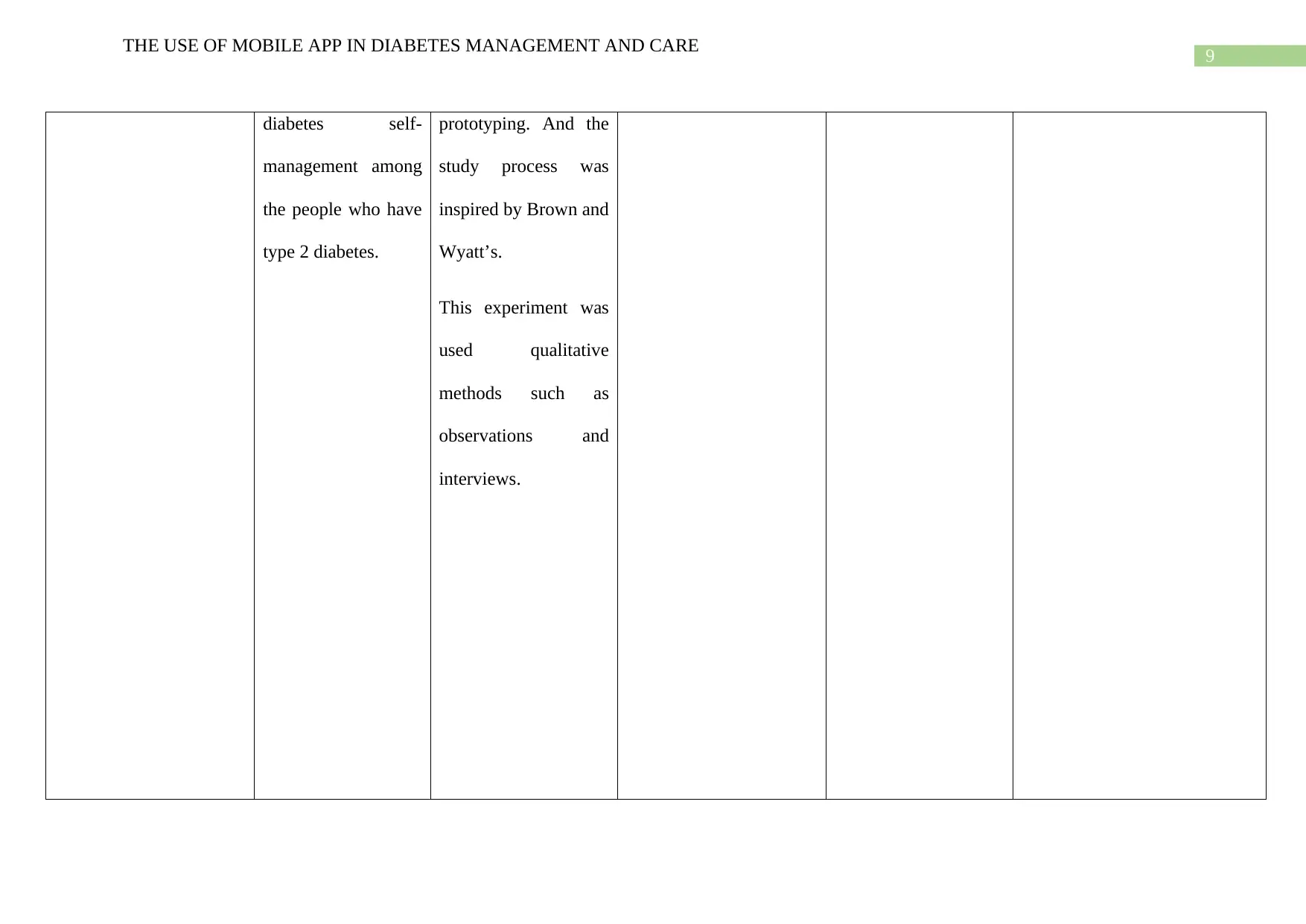
9
THE USE OF MOBILE APP IN DIABETES MANAGEMENT AND CARE
diabetes self-
management among
the people who have
type 2 diabetes.
prototyping. And the
study process was
inspired by Brown and
Wyatt’s.
This experiment was
used qualitative
methods such as
observations and
interviews.
THE USE OF MOBILE APP IN DIABETES MANAGEMENT AND CARE
diabetes self-
management among
the people who have
type 2 diabetes.
prototyping. And the
study process was
inspired by Brown and
Wyatt’s.
This experiment was
used qualitative
methods such as
observations and
interviews.
Paraphrase This Document
Need a fresh take? Get an instant paraphrase of this document with our AI Paraphraser
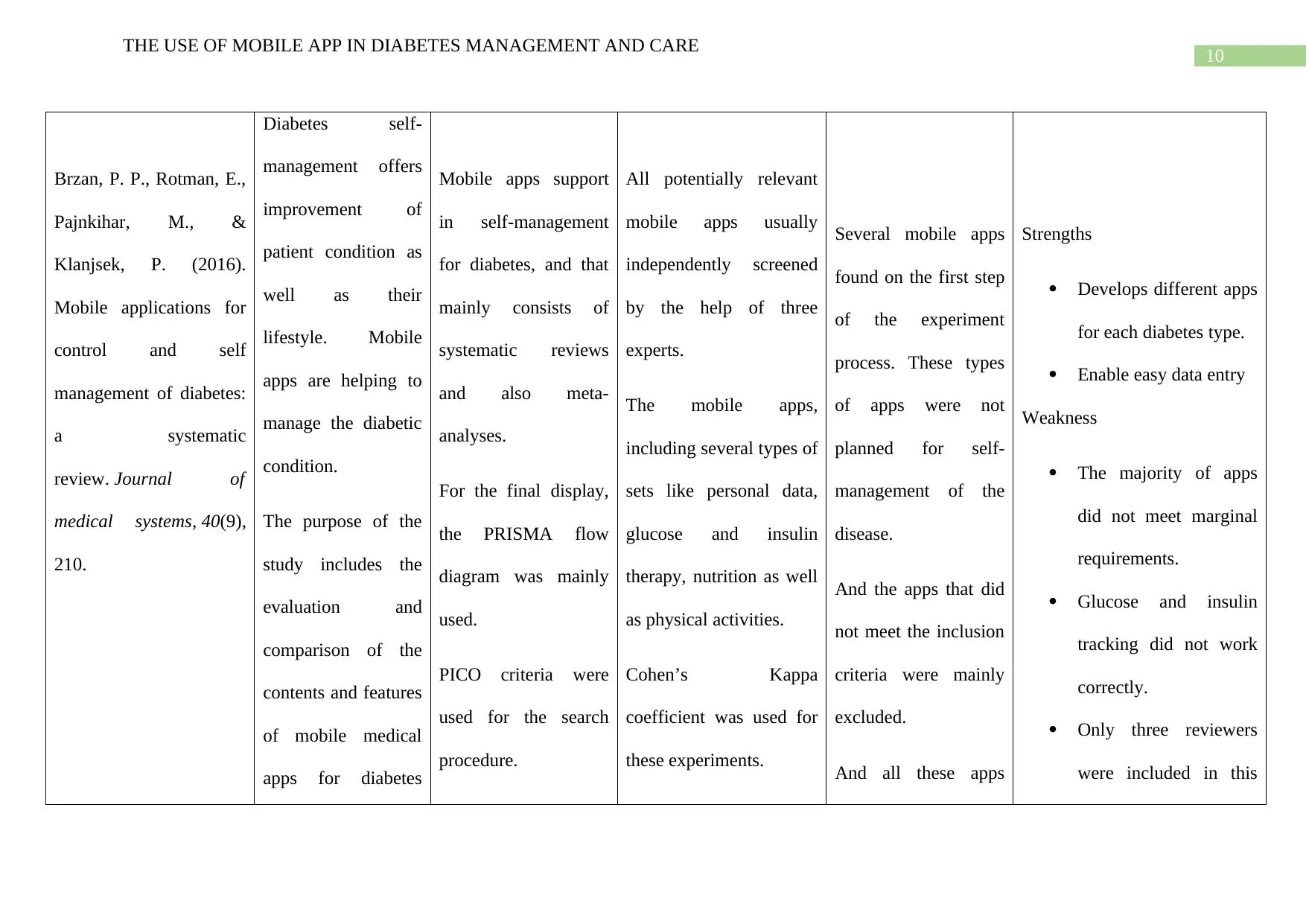
10
THE USE OF MOBILE APP IN DIABETES MANAGEMENT AND CARE
Brzan, P. P., Rotman, E.,
Pajnkihar, M., &
Klanjsek, P. (2016).
Mobile applications for
control and self
management of diabetes:
a systematic
review. Journal of
medical systems, 40(9),
210.
Diabetes self-
management offers
improvement of
patient condition as
well as their
lifestyle. Mobile
apps are helping to
manage the diabetic
condition.
The purpose of the
study includes the
evaluation and
comparison of the
contents and features
of mobile medical
apps for diabetes
Mobile apps support
in self-management
for diabetes, and that
mainly consists of
systematic reviews
and also meta-
analyses.
For the final display,
the PRISMA flow
diagram was mainly
used.
PICO criteria were
used for the search
procedure.
All potentially relevant
mobile apps usually
independently screened
by the help of three
experts.
The mobile apps,
including several types of
sets like personal data,
glucose and insulin
therapy, nutrition as well
as physical activities.
Cohen’s Kappa
coefficient was used for
these experiments.
Several mobile apps
found on the first step
of the experiment
process. These types
of apps were not
planned for self-
management of the
disease.
And the apps that did
not meet the inclusion
criteria were mainly
excluded.
And all these apps
Strengths
Develops different apps
for each diabetes type.
Enable easy data entry
Weakness
The majority of apps
did not meet marginal
requirements.
Glucose and insulin
tracking did not work
correctly.
Only three reviewers
were included in this
THE USE OF MOBILE APP IN DIABETES MANAGEMENT AND CARE
Brzan, P. P., Rotman, E.,
Pajnkihar, M., &
Klanjsek, P. (2016).
Mobile applications for
control and self
management of diabetes:
a systematic
review. Journal of
medical systems, 40(9),
210.
Diabetes self-
management offers
improvement of
patient condition as
well as their
lifestyle. Mobile
apps are helping to
manage the diabetic
condition.
The purpose of the
study includes the
evaluation and
comparison of the
contents and features
of mobile medical
apps for diabetes
Mobile apps support
in self-management
for diabetes, and that
mainly consists of
systematic reviews
and also meta-
analyses.
For the final display,
the PRISMA flow
diagram was mainly
used.
PICO criteria were
used for the search
procedure.
All potentially relevant
mobile apps usually
independently screened
by the help of three
experts.
The mobile apps,
including several types of
sets like personal data,
glucose and insulin
therapy, nutrition as well
as physical activities.
Cohen’s Kappa
coefficient was used for
these experiments.
Several mobile apps
found on the first step
of the experiment
process. These types
of apps were not
planned for self-
management of the
disease.
And the apps that did
not meet the inclusion
criteria were mainly
excluded.
And all these apps
Strengths
Develops different apps
for each diabetes type.
Enable easy data entry
Weakness
The majority of apps
did not meet marginal
requirements.
Glucose and insulin
tracking did not work
correctly.
Only three reviewers
were included in this
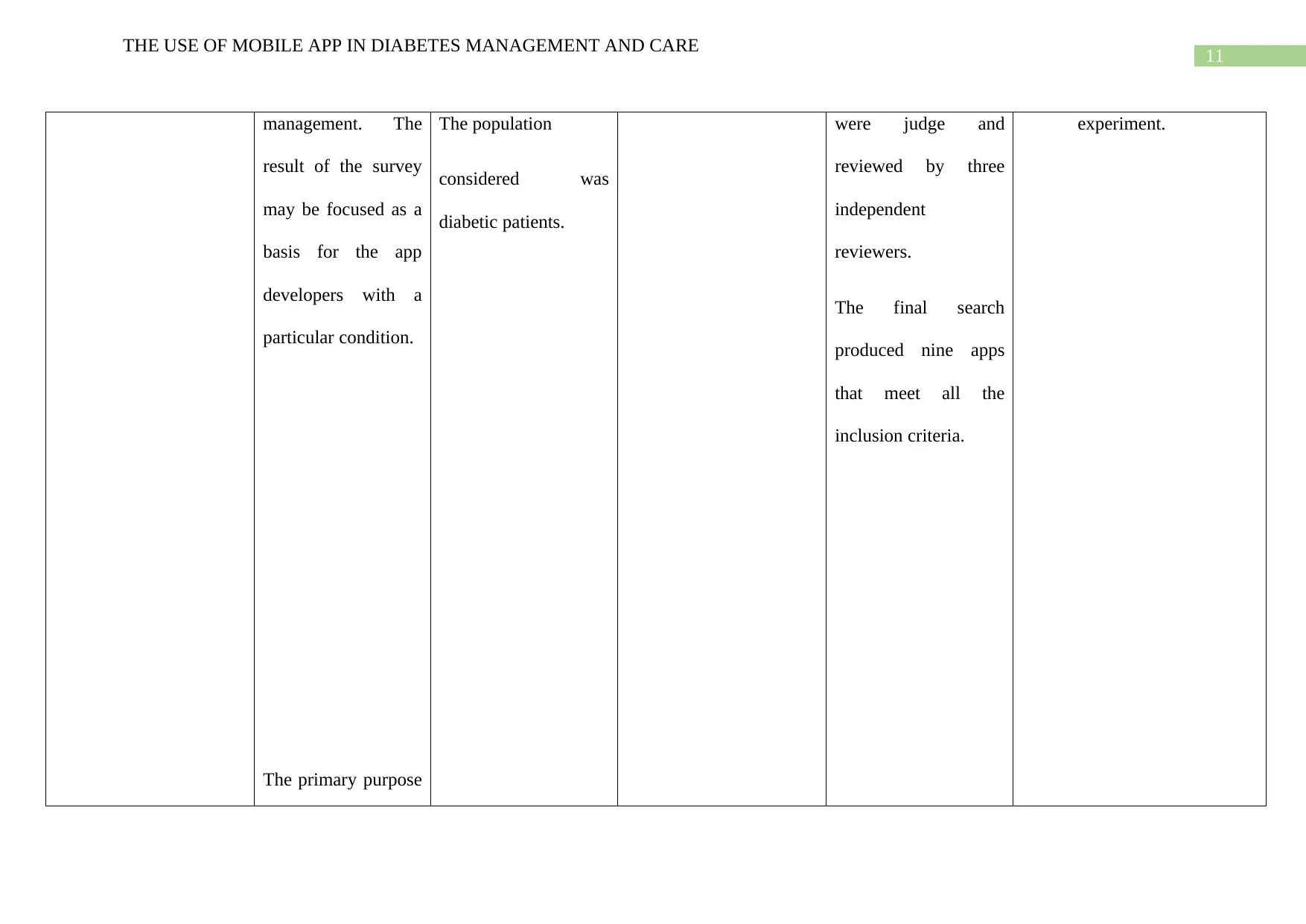
11
THE USE OF MOBILE APP IN DIABETES MANAGEMENT AND CARE
management. The
result of the survey
may be focused as a
basis for the app
developers with a
particular condition.
The primary purpose
The population
considered was
diabetic patients.
were judge and
reviewed by three
independent
reviewers.
The final search
produced nine apps
that meet all the
inclusion criteria.
experiment.
THE USE OF MOBILE APP IN DIABETES MANAGEMENT AND CARE
management. The
result of the survey
may be focused as a
basis for the app
developers with a
particular condition.
The primary purpose
The population
considered was
diabetic patients.
were judge and
reviewed by three
independent
reviewers.
The final search
produced nine apps
that meet all the
inclusion criteria.
experiment.
⊘ This is a preview!⊘
Do you want full access?
Subscribe today to unlock all pages.

Trusted by 1+ million students worldwide
1 out of 15
Related Documents
Your All-in-One AI-Powered Toolkit for Academic Success.
+13062052269
info@desklib.com
Available 24*7 on WhatsApp / Email
![[object Object]](/_next/static/media/star-bottom.7253800d.svg)
Unlock your academic potential
Copyright © 2020–2025 A2Z Services. All Rights Reserved. Developed and managed by ZUCOL.





